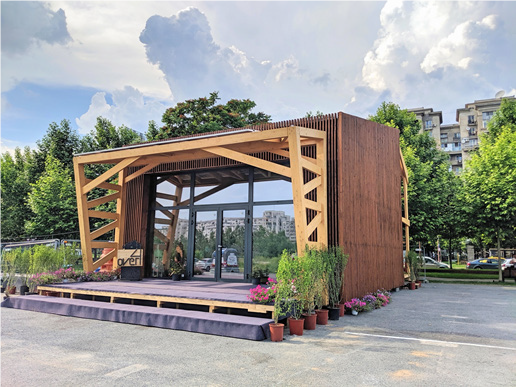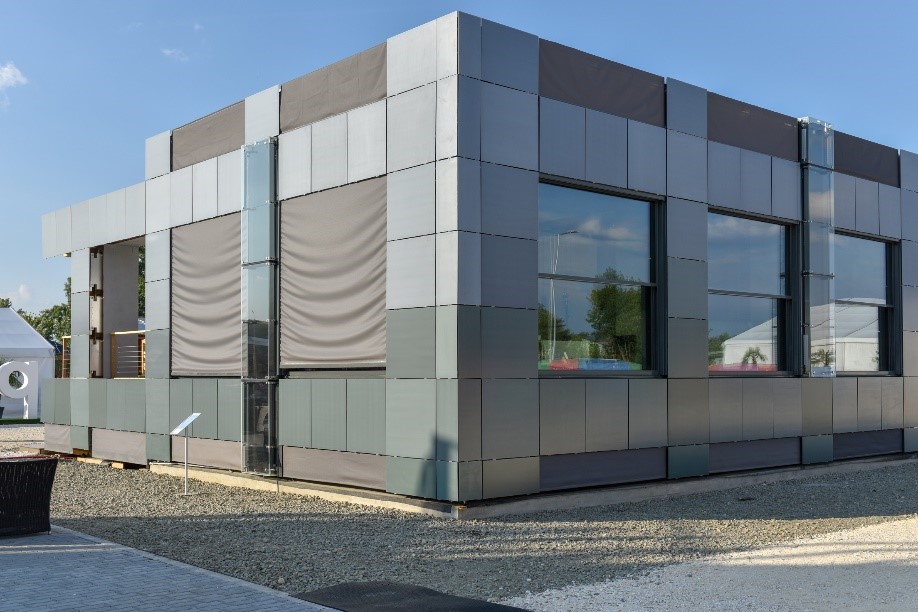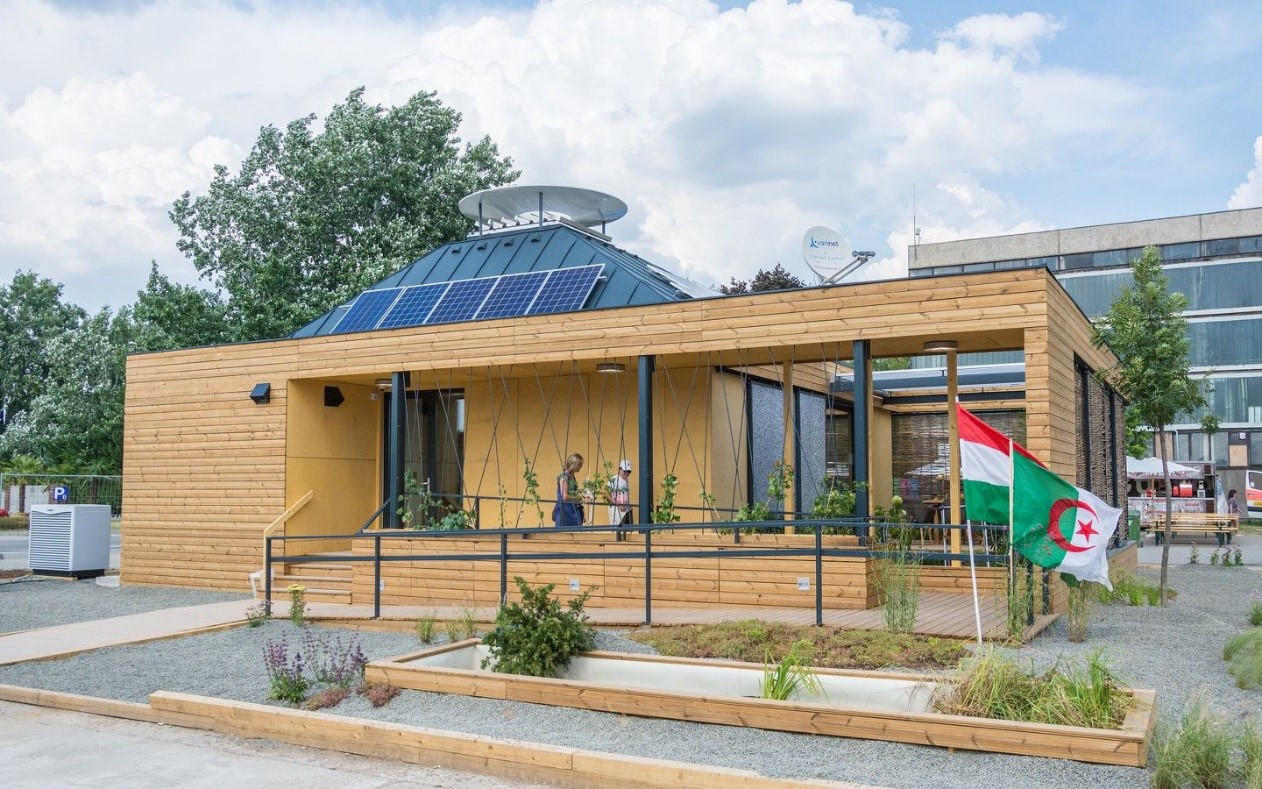Solar Decathlon prototypes
The following prototypes were built during the Solar Decathlon Europe 2019 in Szentendre which is the ultimate international university competition in innovative homebuilding.
Over4

Design: Technical University of Civil Engineering of Bucharest
Further information: http://sde2019.hu/over4_en.html
Over4 prototype represents one module from the rooftop and it is a solar eco-passive house that could be built both as a self-standing house and as part of a passive rooftop. It has been designed and built for being an eco-passive house, by following the 5 principles of Passive House standard: proper thermal insulation, passive glazing, reduced thermal bridges, very good air tightness and an adequate heat recovery ventilation unit. As a result, it is very efficient and comfortable. Transformable interior spaces, the prototype can easily transform from a comfortable home into a co-working space, a fashion show, an art gallery or a common meeting space for the inhabitants. The northern and southern terraces attached to the module offer a common place for gathering people to socialize and relax, while being used both as storage space (north) and integrated Building Integrated Photovoltaics shading (south). Hybrid structure made of glulam frames with OSB panels with mineral wool as insulation is a simple but very efficient constructive system in terms of energy efficiency and modularity. The photovoltaic system (including the PV panels on the Southern terrace - BIPV) produces twice as much energy that the house consumes, the rest of it being injected into the network thus getting financial benefits.
Adopted strategies
- The heat recovery ventilation unit recovers not only the heat from the polluted air exhausted from the indoor space (odours, CO2, VOC, radon), but also recovers the humidity. Thus, the heat recovery system presents a higher efficiency and a lower energy consumption for the heating/cooling load. The efficiency of heat recovery is up to 84%, while the humidity recovery is up to 90%.
- As an innovative material, Romanian sheep wool was used, which is considered as waste by the EU. It is wrapped into a fabric capable of letting the air vapour come into contact with the wool and then apply it directly to the structure of the ladder rail, thus, the wool fulfil a double role – acoustic and air filtering inside the open-space design.
Habiter2030

Design: National School of Architecture and Landscape of Lille
Further information: http://www.solar-h2030.eu
The prototype of Habiter2030 Team is an analogous archetype representing the dimensional, architectural and thermal qualities of the typical 1930s house. Habiter2030 was built by the French team during Solar Decathlon Europe 2019 which is the ultimate international university competition in innovative homebuilding. The original envelope has been transformed with the introduction of a glasshouse extension, which not only provides additional floor area, but also contributes to the natural heating, ventilation and energy production. The Habiter2030 (H2030) house reacts to seasonal changes in response to the needs of its inhabitants.
As part of the rehabilitation strategy the HABITER2030 team transformed the 1930s house by:
- Removing poorly constructed and water-repellent extensions. Wet zones are re-introduced in the centre of the house - often the darkest place.
- Reconnecting the house with the garden, improving the relationship between the exterior and the interior
- Adding a bioclimatic glasshouse extension, providing additional surface, while also improving the living conditions
Adopted strategies
The prototype introduces unique and innovative approaches, combining ingenious products with frugal straightforward solutions, some of which are:
- Photovoltaic roof mounted panels – allowing for the production of 2560 kWh/per year, about twice as much as electrical consumption of a typical 1930s house.
- Thermal solar vacuum tubes installed on the glasshouse façade - heating water used for sanitary use.
- The Glasshouse combined with mechanical ventilation – contributing to the passive heating, cooling and ventilation of the house.
- All those distinctive building materials and technologies work in tandem with an intuitive home automation system adapted to the inhabitants needs and lifestyle.
Mobble

Design: Ghent University
Further information: http://www.themobble.be
Mobble is a flexible module that can be used as a temporary housing unit during the renovation of these buildings. The modular design allows creating custom-sized spaces for each function or inhabitant composition, resulting in a space saving concept with significant energy saving in the longer term. Circularity used as a mean to develop a fast and reversible construction method. This allows to remove building components at the end of the service life of the building and to reuse them in other applications for the remainder of their lifespan, resulting in a saving of raw materials and production energy. Innovative technologies and installations can be incorporated in the building components to resolve the deficiencies by only replacing the building envelope during renovation.Residential apartment building renovation.
Adopted strategies
- ELECTRICITY: innovative solution to combine “non-smart” devices with smart operating control systems by integrating combined PV inverters and their inverter battery.
- HVAC: a performant building envelope, passive strategies and a light weight construction are used in combination with an air to air heat pump to get a fast-responding system.
- PVT PANELS: provide solar energy, heat domestic water or cool water at night, which is stored in a buffer tank to be used as a passive cooling installation during the day.
- IoT TECHNOLOGY: by GPS signals, but also through apps, your smartphone knows when you arrive at home. The control of the HVAC system can anticipate on this expected arrival.
- WATER: closing the water cycle by purification techniques and predictive energy saving control system for safe water without harmful organisms such as legionella.
Azalea

Design: Polytechnic University of Valencia
Further information: http://www.azaleaupv.com
The house is nearly 70m2 and 7m height where the organizational philosophy consists of one compact strip that encompasses all service areas (bathroom, kitchen, machines room and bedroom), leaving most of the space as a diaphanous and flexible area.
- Tradition: Only by considering the roots can we look to the future. Azalea is based on the Barraca, the typical farmer’s house, centuries old in the region, which has become one of the symbols of the city of Valencia.
- Innovation: The prototype, besides including all the facilities of a contemporary house, incorporates new technologies and materials that make Azalea a cutting-edge dwelling, which demonstrates that tradition and innovation can go together.
- Self-sufficiency: Thanks to the energy production of the solar panels, the dwelling is completely energy-independent, capable even of generating more energy than necessary.
- Modular design: Due to the nature of the competition, the joints have been conceived to keep an optimum mechanical performance and guarantee insulation continuity.
- Energy efficiency: The cleanest energy is the one that is not produced. That is why the dwelling includes multiple passive strategies that create a minimal energy demand.
Adopted strategies
- Microencapsulated phase change material that can absorb or release heat and keep its temperature constant.
- Motorized slats located in the south façade, automatically adjusting its openness allowing natural light to enter while avoiding beam radiation and overheating.
- Motorized windows, with East and West orientation, are automatically regulated depending on inside and outside temperatures, playing a key role in natural daytime and nocturnal ventilation as well as in suction chimney strategy, both for passive cooling purposes.
- Innovative energy control system, able to sell or store electricity depending on the real consumption of the user. It also counts with a revolutionary system of hybrid panels, capable of producing electricity and hot water in a single panel.
- The dwelling includes a home automation control system which allows the user to control the lights and climate system. All this can be done thanks to an App.
MOR

Design: Delft University of Technology
Further information: http://www.mor.tudelft.nl
MOR is developing a renovation strategy to renovate underperforming office buildings into net-positive, multi-purpose buildings that are contributors to their environment and catalysts for activities and social interactions.
MOR’s renovation proposal achieves a net-positive footprint:
- Energy+: By producing more energy than the building needs, the surrounding buildings can use that energy, or it could be stored in batteries in case of power outages.
- Air+: An intelligent and efficient system filters the outside air and provides a comfortable and healthy indoor climate.
- Material+: By using ‘design for disassembly’ methods and environmentally friendly materials (high recycle/up-cycle values), the building becomes a material bank: each material is comprehensively recorded in an open-source material passport.
- Water+: Rainwater collected on the roof is used for irrigation, treated grey-water is used in urban parks and farms, and black water is processed with organic waste to generate energy.
- Biomass+: Food, such as mushrooms, vegetables or herbs, is produced in the building through hydroponics systems found throughout the living floors and with a greenhouse on the roof.
Adopted strategies
- The facade tiles are coloured solar panels designed for easy assembly/disassembly, serving a practical and aesthetic function.
- A Helophyte filter system treats waste water to be reused for toilet flushing and irrigation by using. The system first separates the waste from the water, then purifies it with bacteria working together with helophytes to eliminate the contaminants.
- The Green Wall is both an architectural feature and important to the climate strategy. The incoming air is filtered through the plants as it enters the home. Behind it, salt-based PCM help pre-heat the air in the winter and pre-cool it in the summer: minimising the reliance on the more taxing technical systems. A 5m-long PCM battery is used to intelligently increase the performance of the air heat pump.
Hungarian nest+

Design: University of Pecs and Miskolc
Further information: http://www.someshineproject.hu
“Nature is not a place to visit, it is our home". The explanation of this thesis lies not only in the application of using of natural materials and the utilization of green energies, but also special emphasis is placed on embedding the building in a natural setting. Augmented Garden Reality of Inner Living Space, with the green roof planted roof and with the living vegetation in the courtyard, atrium provides the oxygen-rich space essential for a healthy life.
- The Venturi plate: it helps passive ventilation in summer, while in winter it makes internal sun exposure possible from the roof by the integrated mirrors.
- Mobile living spaces: with free combination of the elements of the prototype, it can react on the differences in size and on the structure deficiencies of families in case of any kind of installation.
- “Smart” furniture: incorporating "smart" furniture made of recycled materials, so that the building can provide new features for changing needs and different family structures.
Adopted strategies
- Some of the furniture has been designed as part of the RETEXTIL movement, which means the products are made by cutting and knotting used clothes.
- The live flora placed in the “Venturi Atrium” and the patio/day space are the self-sustaining oxygen base of the house.
- Mixing active and passive energy/mechanical systems for a sustainable energy balance.
- Natural light flux control: the flow of natural light into the building is influenced by the rethinking of traditional passive devices compared to the seasons.





